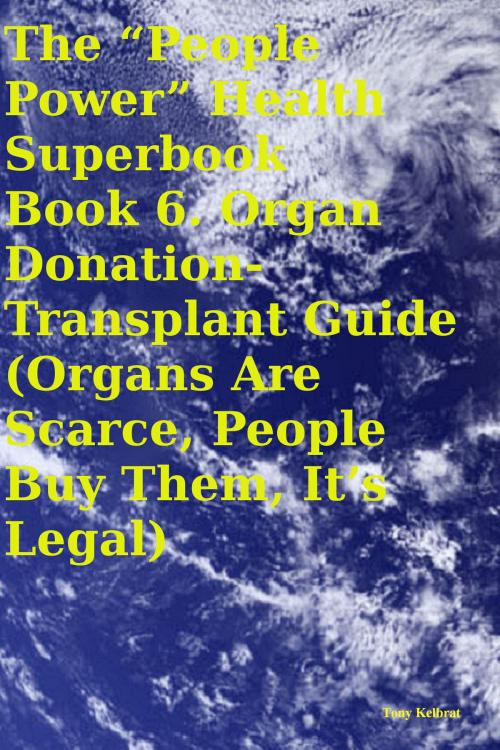The “People Power” Health Superbook Book 6. Organ Donation-Transplant Guide (Organs Are Scarce, People Buy Them, It’s Legal)
Nonfiction, Health & Well Being, Health| Author: | Tony Kelbrat | ISBN: | 1230000222444 |
| Publisher: | People Power | Publication: | March 2, 2014 |
| Imprint: | Language: | English |
| Author: | Tony Kelbrat |
| ISBN: | 1230000222444 |
| Publisher: | People Power |
| Publication: | March 2, 2014 |
| Imprint: | |
| Language: | English |
Organ transplant is the process of replacing diseased organs with healthy ones. After that, the patient must take anti-reaction drugs for life.
You can donate a few organs and still keep the body intact for a funeral or you can donate the body completely. You receive no pay although some places now are buying people's bodies in advance for when they die.
Someday, technology will be evolved enough such that we can either grow organs in a lab or in animals or make artificial ones but for now, we have to transplant them from a donor, often a relatively young person who has died with some of his or her organs intact.
Because the demand greatly outnumbers the supply and certain features have to be matched like common blood type, most people who need a new organ are put on a waiting list. Some get their transplant, others die before they get the chance.
A transplant is the surgical implant of a healthy human organ or tissue to replace a defective one. Presently, organs are mostly taken from the body of an organ donor who has died while some organs such as the kidneys and bone marrow can come out of living people without adversely affecting their health.
Sometimes the transplant tissue, such as skin or bone marrow, can come from elsewhere in the patient's own body.
At the present time, the most common transplants are:
Heart.
Lung.
Liver.
Kidney.
Pancreas.
Bone marrow.
Eye cornea.
Small intestine.
Fingers, toes, limbs.
Heart valves.
Skin.
Bone, etc.
The tissues that can be donated include corneas, skin, bone, middle-ear, bone marrow connective tissues, kidney, heart, liver and blood vessels.
People who require a transplant are placed on a national waiting list. As organs become available, the organ procurement organization serving that region searches its computerized listing and identifies the most appropriate potential
recipient.
The older you are, the less appropriate you're considered to be. Other factors considered for organ transplant are medical compatibility between donor and recipient on tissue type, blood type, weight, the length of time on the waiting list and the urgency of the recipient's need as indicated by a formal classification system as follows:
Status 1, currently in a hospital intensive care unit and have a life expectancy of less than seven days without a transplant;
Status 2, have been continuously hospitalized for at least five days;
Status 3, require continuous medical care;
Status 4 patients are at home and function relatively normally.
Organ transplant is the process of replacing diseased organs with healthy ones. After that, the patient must take anti-reaction drugs for life.
You can donate a few organs and still keep the body intact for a funeral or you can donate the body completely. You receive no pay although some places now are buying people's bodies in advance for when they die.
Someday, technology will be evolved enough such that we can either grow organs in a lab or in animals or make artificial ones but for now, we have to transplant them from a donor, often a relatively young person who has died with some of his or her organs intact.
Because the demand greatly outnumbers the supply and certain features have to be matched like common blood type, most people who need a new organ are put on a waiting list. Some get their transplant, others die before they get the chance.
A transplant is the surgical implant of a healthy human organ or tissue to replace a defective one. Presently, organs are mostly taken from the body of an organ donor who has died while some organs such as the kidneys and bone marrow can come out of living people without adversely affecting their health.
Sometimes the transplant tissue, such as skin or bone marrow, can come from elsewhere in the patient's own body.
At the present time, the most common transplants are:
Heart.
Lung.
Liver.
Kidney.
Pancreas.
Bone marrow.
Eye cornea.
Small intestine.
Fingers, toes, limbs.
Heart valves.
Skin.
Bone, etc.
The tissues that can be donated include corneas, skin, bone, middle-ear, bone marrow connective tissues, kidney, heart, liver and blood vessels.
People who require a transplant are placed on a national waiting list. As organs become available, the organ procurement organization serving that region searches its computerized listing and identifies the most appropriate potential
recipient.
The older you are, the less appropriate you're considered to be. Other factors considered for organ transplant are medical compatibility between donor and recipient on tissue type, blood type, weight, the length of time on the waiting list and the urgency of the recipient's need as indicated by a formal classification system as follows:
Status 1, currently in a hospital intensive care unit and have a life expectancy of less than seven days without a transplant;
Status 2, have been continuously hospitalized for at least five days;
Status 3, require continuous medical care;
Status 4 patients are at home and function relatively normally.















